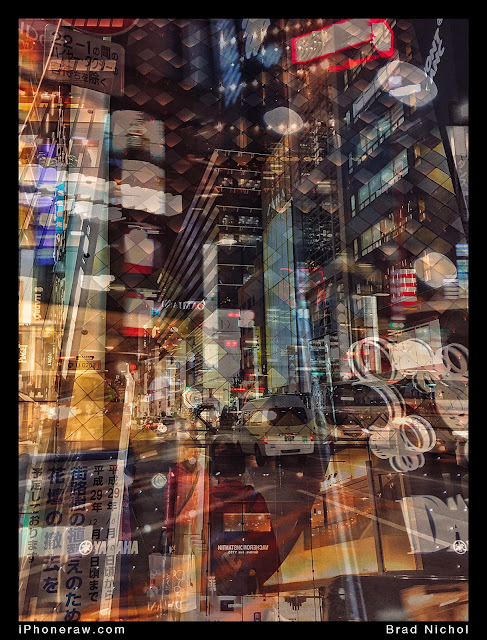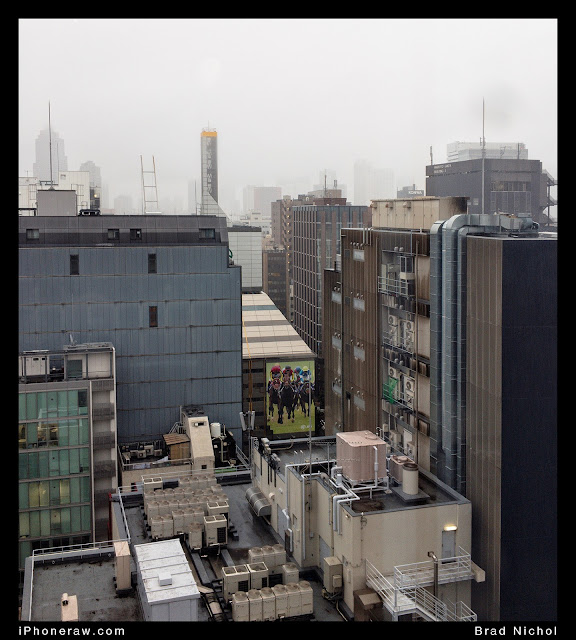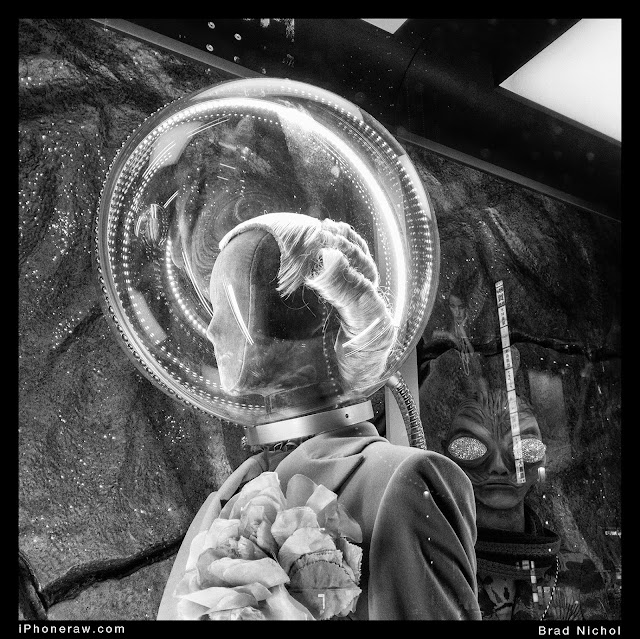Ginza Neon Composite, iPhone using Average Cam Pro
As on all holidays, I take both my iPhone and my Olympus M4/3 camera kit, the Oly gets a workout on the more serious stuff, especially where I need more telephoto reach or subject separation and the iPhone goes with me everywhere else.
I thought some of my readers might be interested in seeing a little photo story of the Ginza district and immediate surrounds in Tokyo captured whilst my wife and I wandered the shiny streets.
Ginza itself is 87 hectares of high end, over the top, consumerist worshipping retail nirvana for Japanese with money to burn and a need to proclaim their superior status. The Ginza area provides a fascinating insight into the culture of modern Japan and presents photographers with a literal feast of options, both for the tummy and the lens. Beyond Ginza lie an array of fabulous parklands and probably most importantly the Imperial Palace grounds.
Stainless steel, glass and acrylic Ginza style.
My wife and I along with my Son Aaron and his partner Jain spent 6 days in Tokyo recently, staying in a hotel in Ginza. https://www.gardenhotels.co.jp/eng/millennium-tokyo/ . The lodgings were superb and ideally located for access to the Ginza district, subway system and within easy walking of great eateries where you can exercise your gastronomic muscles.
https://www.gardenhotels.co.jp/eng/millennium-tokyo/ .
Halloween is huge in Tokyo and is relatively new to the country.
Like many high-end shopping precincts around the world, Ginza is dripping with the usual brands, except perhaps the presentation is little more excessive than usual. Considering that Ginza is home to some of the worlds most expensive retail real estate in "dollars per meter squared terms", that excessiveness becomes all the more impressive, especially when you compare retail space sizes to the small residential spaces of Japanese units and homes.
Ah Ginza, it's all "be-on-neon, sidewalk fashion parade and busy with a purpose". But, my friends, in case you are thinking it would be like, say Times Square or some similar location in other parts of the western world be assured that Ginza has a flavour that's entirely different and in many ways uniquely Japanese, which is what makes it so fascinating.
Window displays are not done by half measures.
First the familiar, Ginza is devoted to the church of conspicuous consumption and the brands of choice are the same as almost everywhere else, Cartier, Hermes, Prada, Gucci and all the other usual suspects. Most of the shoppers are women, and indeed most of the stores are aimed at women, and of course, there are a lot of very nicely dressed people parading under the bright evening lights.
As always the store window displays are works of art but not dissimilar to the same store displays found in other locations around the world, just as you would expect in these days of corporate uniformity and branding.
Typhoon season in Japan means rain and lots of it. My wife Wendy takes shelter under the standard Japanese clear umbrella. Many of the streets are clear of cars on Sundays, this is the main drag, Chuo-dori.
Bleak day from the 9th floor of G.Itoya stationary store.
Rain sodden laneway in Ginza, neon lights are everywhere.
The whole Ginza edifice is built on the concept of consumption rather than materialism, the joy is in the shopping, browsing, touching, and ultimately parading the high-end bags along the streets post-purchase. You can take it as a given that younger Japanese are keen shoppers and love the idea of having the latest gadget, fashion or items of consumer desire.
Of course, most non-food purchases in the Ginza area fall into the category of a "declaration of status" rather than fulfilling any real need for body covering, personal hygiene or practical necessities, such needs would generally be met elsewhere in Tokyo. You don't go to Ginza to buy soap, well you might, so long as it was luxuriously scented, exquisitely packed and being sold at a premium, then popped into a flash labelled bag.
Gucci window display on Harumi-dori
The Aliens have arrived in time for Halloween, another high end fashion store on Harumi-dori.
I read an interesting article yesterday on the issue of consumerism and materialism, it's well worth a look if you have the time and probably typifies the drive behind Ginza more than anywhere else in the world except perhaps Dubai.
https://www.theguardian.com/business/2017/oct/30/to-cure-affluenza-we-have-to-be-satisfied-with-the-stuff-we-already-own
Tea shop in a department store, incredible packaging.
But now for something completely different, Ginza is also home to some incredible Japanese department stores that sell brands and foods which are uniquely Japanese, examples being Mitsukoshi, Matsuya and Wako. You may not wish to buy anything at all but I promise a walk through the food halls alone will leave the average westerner agog at the quality and presentation of the foods and even more impressed at the vast range on offer.
Beyond the department stores, you have speciality shops that are also uniquely Japanese, such as G.Itoya stationary store and Hakuhinkan toy store (or more accurately toy emporium).
G.Itoya has a whole floor devoted to paper alone.
It is possible to explore Ginza at a subterranean level moving from shop to department store etc via the subway paths, very handy in Typhoons and many folk choose this option to avoid traffic and crossings.
Move out onto the streets, and you'll notice several other aspects. First, there are relatively few high-end European cars, the vast majority of vehicles are taxis, and almost all of them are black old-school Toyota Crowns that seem ideally suited to their purpose and are always immaculately clean. In fact, all vehicles in Tokyo including commercial trucks seem to be fresh from the carwash, which is quite profound when you make comparisons to most cities around the world.
The link below will give you some insight into the Tokyo taxis.
http://autoweek.com/article/car-life/unsung-taxi-heroes-tokyo-toyota-crown-sedan-and-crown-comfort.
Lexus LS 430, modded and bagged on Ginza.
Private passenger vehicles in Ginza tend to by high-end Toyotas and Lexuses, there are few other brands on display, maybe the occasional high-end Nissan, but frankly, I think about half the worlds fleet of Lexus HL600s must reside in Ginza alone.
The most unique Japanese vehicles you'll see in Ginza are the Toyota Century sedans which is Japans most prestigious vehicle and is almost always chauffeur driven. The conservative but exquisitely built Century is the vehicle of choice for CEOs, Government Officials and the very wealthy, it's the ultimate Japanese automotive statement.
Oddly a Century with the Chauffeur in situ seems able to be parked anywhere with complete immunity from harassment by Police or parking officers. The Century looks bland in photos, but in reality, upon the Ginza pavement, a century is imposing, regal and stylish in an old school way.
A midnight blue Toyota Century, the build quality is incredible and the motor a V12. If you have a chauffeur driven Century in Japan you have made it!
Nissan Hyper Car concept prowling Ginza from behind glass on Nissan Corner.
Your ears will notice, or should that be, not notice something else. For such a busy place the traffic seems remarkably quiet, no loud exhausts and definitely no horns, in our entire time there I only recall hearing a car horn on a couple of occasions. Generally, cars are driven in a calm, sedate and orderly fashion, the complete opposite of the madness you might experience in say, Rome.
The streets of the Ginza and surrounding area are a combination of vast avenues and narrow thoroughfares, almost all are one way. The pavements are spotlessly clean, absent of buskers, beggars, pavement furniture, advertising boards and other physical impediments thus walking around is easy.
Don't cross against the lights, Japanese happily wait at red walk lights regardless of the traffic flow or non-flow and frown on those who disregard the signs. People move with purpose, but in an orderly fashion, there's no pushing and shoving, defintiely no talking loudly on phones, or aloud to one another. Good manners are pivotal, but that's true of Japan generally.
The Tokyo Plaza Crossing
Abstract made from a window display across the road from Nissan Corner
Regarding fashion, Ginza is conservative, the Japanese women do not flaunt sexuality but rather dress immaculately in beautiful materials all exquisitely cut and then tastefully trim with discrete jewellery. "Refinement" is a word that sums up the fashion style of Ginza ladies, whilst the men tend towards the universal black suit, shoes and white shirt, in other words, the typical business uniform one would expect to see in the financial districts of Manhatten.
Of course, Ginza is not all about shopping, there is much eating to be done as well. From the food halls in the basements of the department stores, through to the myriad of speciality restaurants, there's an option for almost every palette, except perhaps for those looking for typical American style fast food. KFC and McDonalds are present but much rarer than in other cities.
One constant however are coffee shops, there are Starbucks and equivalent style shops on every block, but I'd say for "Coffee Culture" loving Aussies like ourselves the coffee is generally a disappointment with the exception of a few specialist coffee shops.
Tea with a gold strainer and a timer.
Ginza is close to many of the other Tokyo delights such as Imperial Palace and Gardens, the Fish Market, Tokyo Tower and a wealth of other tourist locales. The metro system is highly efficient and cheap, placing you within striking distance of almost anything you could wish to see within around 30 mins or maybe less. For Aussies used to the vagaries of Sydney trains and buses, forget everything you have ever experienced, Tokyo despite its massive 24 million population just works, "on time, every time"!
Classic Ginza street at dusk.
Just to finish up on the technical side of things, the iPhone pics are mostly DNG captures, but there are some JPEGs shot on the standard app when it suited, and the multiple exposures were all JPEGs shot in Average Cam Pro. As always the DNG files were extracted in Lightroom Mobile (now known as Lightroom CC) and I have done a little fine tuning on Snapseed.
The Olympus pics were shot on my EM5 Mk2, with mainly the cheap Panasonic 14-42 series 2 or the super compact Panasonic 35-100 zoom using RAW. You can check out my recent review of the latter lens here:
https://braddlesphotoblurb.blogspot.com.au/2017/10/the-perfect-m43-holiday-companion.html
The frames were done in Photoshop and in some cases, a few small selective edits were made whilst there.
A lovely spot in the East Gardens of the Imperial Palace, not far from Ginza.
Hibiyakoen, a wonderful park and an easy walk from central Ginza.
Painters are found all around the East Gardens
Taking time out in the East Gardens to contemplate the day.
The gardens offer serenity and a delight to the eyes.
Guard at the Imperial Palace
Business men commonly cycle, Tokyo is welcoming of cyclists, no helmet needed and you can ride on the footpath.
Would you like to learn how to shoot the ultimate RAW images on your iPhone, I have a new eBook on the iBooks store, "Ultimate iPhone DNG". You will be amazed at just how much better your iPhone images can be, the book contains information not published anywhere else, it's easy to follow and will be of benefit to iPhone shooters at all levels. Over 400 pages of iPhone RAW goodness and there are another 5 books in the series coming up with "Ultimate iPhone Composition" due for release before Christmas.
https://itunes.apple.com/us/book/ultimate-iphone-dng/id1274334884?ls=1&mt=11

























No comments:
Post a Comment